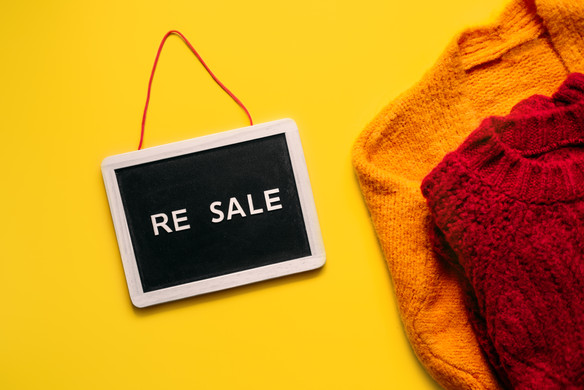Table of contents
The resale industry is on the rise, and so are the opportunities for your retail store. According to OfferUp, the secondhand apparel industry in North America is expected to grow 5x faster than the overall retail market — faster than any other region across the globe. With resale companies like Depop, The RealReal, and ThredUp having been around for over a decade (and some even longer, hi eBay), it’s important to note that the resale industry has been a billion-dollar industry since at least 2008 and is steadily growing. But with recent inflationary pressures, economic uncertainty, and large brands like Target, IKEA, and Adidas throwing their hat into the mix, there’s been an influx of interest in secondhand goods that’s poised to stay well beyond 2023.
In fact, shoppers plan to spend more money on secondhand items in the next five years than any other retail segment, including luxury, fast fashion, department stores, Amazon, and more. This is especially true for millennials and Gen Z. For an industry that’s expected to top $141 billion in 2023 with continued growth toward $218 billion in 2026, understanding how your business can benefit can have tangible benefits for your bottom line.
But before you take the next step toward making it a reality, let’s break down the basics.
What’s the difference between resale, resell, and consignment?
There are plenty of terms used (often interchangeably) to describe secondhand goods and it’s crucial to understand the meaning and the subsequent differences between each one before determining the opportunity for your retail store.
Resale: Resale is the sale of items that were previously purchased, i.e., secondhand goods. Resale-as-a-service is an extension of this idea that involves marketplace tech and helps retailers manage logistics, fulfillment services, and more. Recommerce is also another name for this.
Resell: Resell is the act of selling an item to someone else, often on a peer-to-peer basis. An important distinction is that resold items aren’t always previously used or worn. They can often be bought and marked up or marked down by individual sellers.
Consignment: Consignment is the act of selling one’s goods through a third-party vendor like a consignment store or an online thrift store. The third party pays the seller a percentage of the proceeds after the goods are sold. An important distinction is that consignment is its own unique business model.
While each term has subtle, unique differences to keep in mind, they are all a part of the circular economy. For the purposes of this content, however, we will continue to focus on resale.
Why is resale gaining popularity?
Reclaim your revenue and brand image
Resale-as-a-service can have an impact on everything from finances to the environment to the customer. When partnering with platforms like ThredUp or The Real Real, you reclaim a chunk of revenue that would otherwise be lost to individual sellers opting for resell. In some instances, items can be sold three or four times and each time your business stands to make a profit. Eighty-eight percent of resale executives have said resale has helped to drive revenue. Reclaiming this revenue can also have implications for your brand. When individual sellers resell your items online, they can represent your brand in a way that may not align with your core mission and values.
Widen your customer base
Selling your items on resale-as-a-service platforms exposes your items to customers that may not have been initially looking for your goods. Imagine a customer is shopping for a new pair of shoes and your shoe selection is the only one that meets their price point and design preference. You gain a new customer instantly. If they’re subsequently happy with the comfort level of your shoe, you make it easy for them to become a repeat shopper.
Resale also opens your brand up to a new generation. Sixty-two percent of Gen Z and millenials say they look for an item secondhand before purchasing it new. Furthermore, according to NASDAQ, Gen Z would pay 10% more for clothing that’s sustainable.
Reduce your carbon footprint and commit to sustainability
By extending the lifespan of an item, you subsequently reduce the amount of textile waste your brand accumulates and the impact it can have on potential landfills. Not only does this have long-term benefits for the environment, but it also appeals to customers who want to shop with brands that practice sustainability.
What are the key considerations to providing resale options?
As with any business, resale comes with its own set of challenges and considerations. Weigh the pros and cons and determine the best course of action for your business and your customers.
Determining your price point
Setting fair and competitive prices are a standard part of the industry, but when it comes to resale it becomes even more important. Individual sellers may opt to sell the same or similar items for an extremely low price and appeal to more customers. Do your research and analyze the best way to price your resale goods, keeping in mind the quality and the current age of the item (i.e., how long ago the item originally hit stores).
Pro-tip: Listing the shipping fee on the item listing is common practice in the reselling world. Consider placing your shipping fee on the pages of your listed items to give sellers a clearer picture of what to expect at checkout.
Verifying quality and authenticity
Buying secondhand items online can make it hard for customers to verify quality. Because of this, having quality photos of all items is crucial for your marketplace. Capture close-ups of any wear and tear to assure buyers of the true item quality. If there is any minor damage or a defect in the item that’s hard to photograph, be sure to specify any notes in a “condition” section on the listing. Conversely, if the item is in like-new condition, be sure to capture that as well.
Training staff to authenticate the secondhand item is also important. Conduct thorough conversations with your staff about what to look for and telltale signs for fake or false items.
Managing the logistics
There’s a variety of ways to manage a secondhand resale marketplace. If you’re a brand that decides to handle all of the logistics solely in-house, from intake to inventory tracking to shipping, it can mean a lot of work for your staff. Partnering with resale platforms that offer resale-as-a-service can make a lot of the work seamless and easier, but there’s just one aspect that can’t be predicted: inventory. If your store sells multiple categories of merchandise, there’s a chance there might be an overflow of handbags for resale, for example, but low shoe offerings. While there are ways to combat this — like promoting your marketplace with Square Marketing or offering customers incentives to resell with options like Square Loyalty — it’s important to be aware of possible shifts in available inventory.
Understand your audience and discover if there is adequate demand (with subsequent intake) for your store before you launch a resale marketplace to get in front of any potential inventory challenges. Using customer data from Square can help. If there’s a high return rate for a particular item(s), there’s a chance that the item(s) could do well in a resale program.
There are also different ways to launch a resale marketplace to take some of the pressure off of you and your staff.
Methods to launching a resale marketplace
Buyback programs
Launching a resale marketplace can take shape in many different ways. For brands like IKEA, their resale program functions as a buy-back offering for used goods. In their Buy Back & Resell program, IKEA buys back customers’ gently used home goods and gives them a store credit in return. The gently used items live in their as-is department for shoppers to browse through when they’re looking for a deal, furniture already assembled, or simply a more sustainable way of living.
Buy-back programs (or take-back programs) are a great way for retailers to cut back on a lot of the logistics, like shipping and online inventory management, that come with online resale programs by keeping the entire process in stores. It’s also an easy way to gauge your customers’ interest in resale overall.
Customer exchange programs
Another way to launch a resale program would be to host a peer-to-peer resale platform. Retail giant Shein launched a new program titled Shein Exchange, where users can purchase and sell previously owned Shein apparel. Options like these place a large portion of tasks associated with the sale on customers in the same way other marketplaces, like Poshmark or eBay, do.
One of the biggest incentives to hosting a peer-to-peer resale option on your retail site would be to reclaim your brand image and a portion of the revenue that’s lost to other marketplaces. It also keeps online traffic within the brand and creates an opportunity to accumulate new sales if a customer discovers that a resale option is unavailable and there’s a new item that would work better.
Partnering with a third-party platform
Partnering with resale-as-a-service platforms like ThredUp, Recurate, Treet, and others makes selling secondhand goods online much more manageable. Depending on the platform, time-consuming tasks, such as orchestrating the launch to processing and fulfillment to customer support, are all handled for you. In the interest of making recommerce options as low a lift as possible, certain platforms also offer to help with resale strategy, item verification, and even provide your customers with clean-out kits for their closets to help build your inventory.
Clothing brands such as Athleta and Madewell have partnered with ThredUp to sell pre-owned clothing, and bigger brands like Target are even looking to get involved with recommerce to better serve their customers and deliver on their commitment to sustainability.
Off-price program
When customers return items and other buyers later discover minor marks on them, retailers usually mark them down or add them to a clearance rack in their store. The same is true when goods accidentally get damaged in-store. Whether you’re an online retailer only or a store that operates online and in stores, you can also benefit from resale with specific resale programs called “brand supply,” “returns,” or “off price,” depending on the platform. These programs essentially make it so that you can still benefit from items that are in any condition that’s different than originally intended.
While these programs have a unique benefit for eCommerce stores, they can also be options for physical stores that want to keep damaged or altered goods separate from their new inventory. It’s also a great way to explore resale without used or preworn items. An added benefit is that many platforms will still handle a lot of the logistical components for you if desired.
How to get started with a resale program
The world of resale is vast and continuously growing. As retailers continue to find ways to control their own resale markets, it’s important to determine three key elements before diving in:
- Need: Assess whether or not there is a desire for this within your customer base. Square Feedback is a great way to determine new opportunities your customers are searching for related to your business. If you’re a store that already offers resale, asking for feedback on overall satisfaction and areas for improvement could help make your program even better.
- Type: As we’ve discussed, there are plenty of ways to get involved with the resale marketplace. From solely online to solely in-store to a mixture of both, figure out which way would work best for your business.
- How: If you’re interested in having your resale options exist solely online, there’s the decision of whether your business should host its own platform within its current site or partner with a resale-as-a-service technology platform. If you go with a platform, there’s the added step of researching all of the options available to you and determining which one suits your needs best. Maintaining your resale completely in-house means figuring out ways to successfully manage the logistics between you and your staff, which can mean more work and potentially more hours. This is true whether in-house for your business means online, in-store, or both.
Overall, resale is becoming increasingly important to consumers with plenty of benefits for the retail industry and businesses as a whole. While there are a few challenges that can be easily solved for, remember to keep the health of your business and the customer experience top of mind.
![]()











